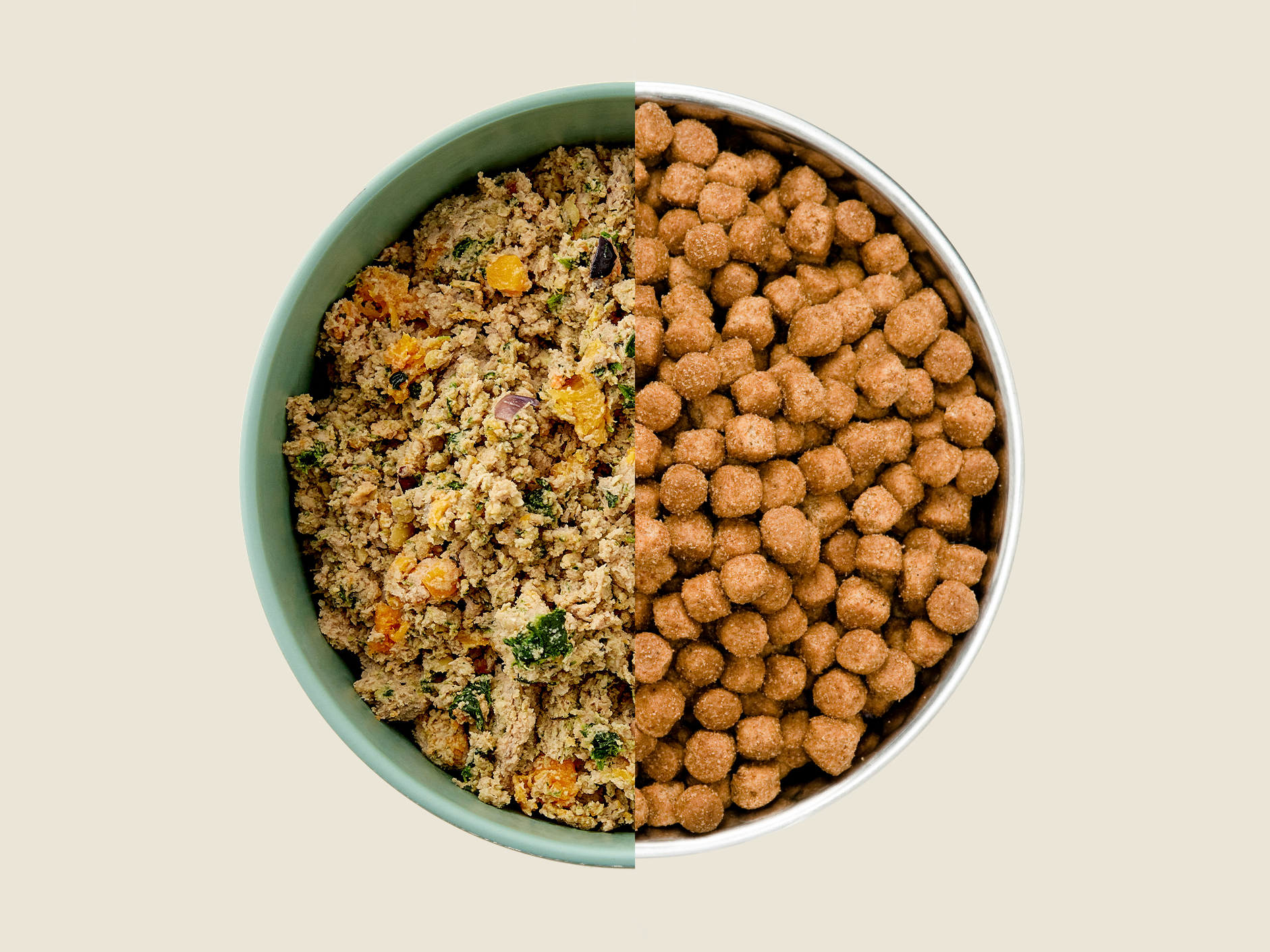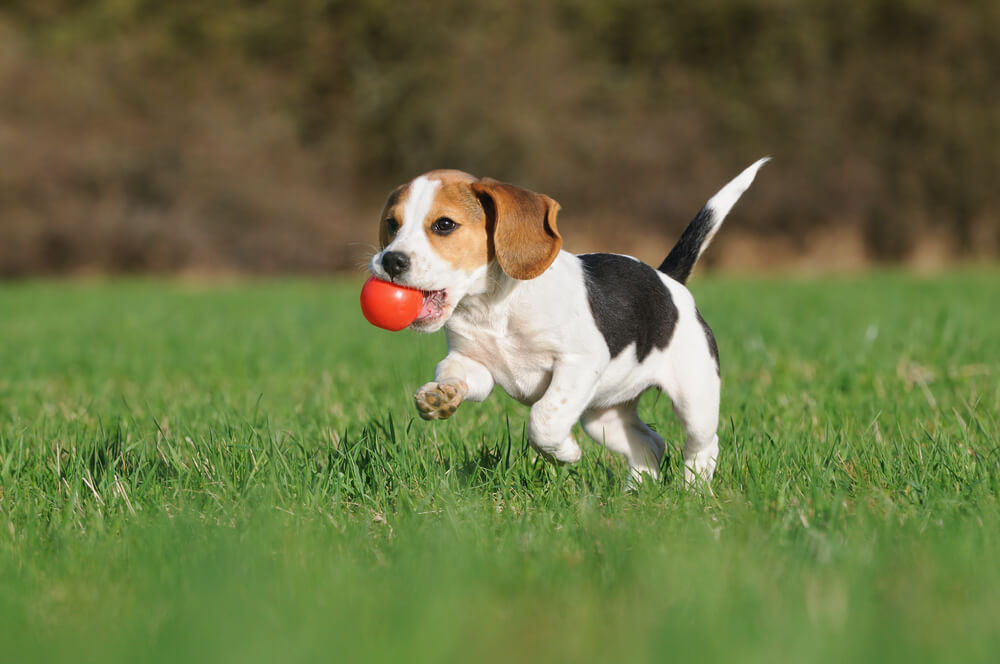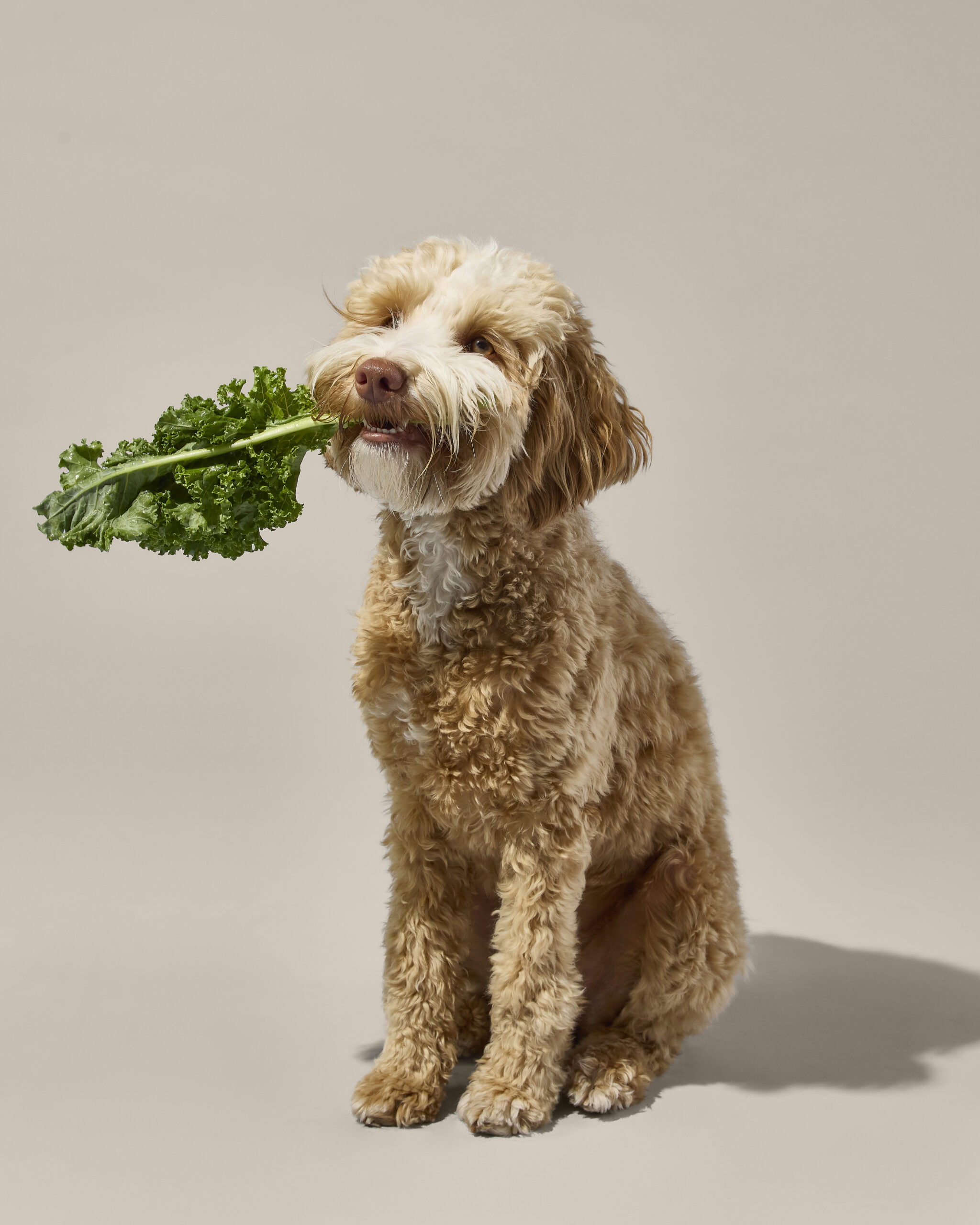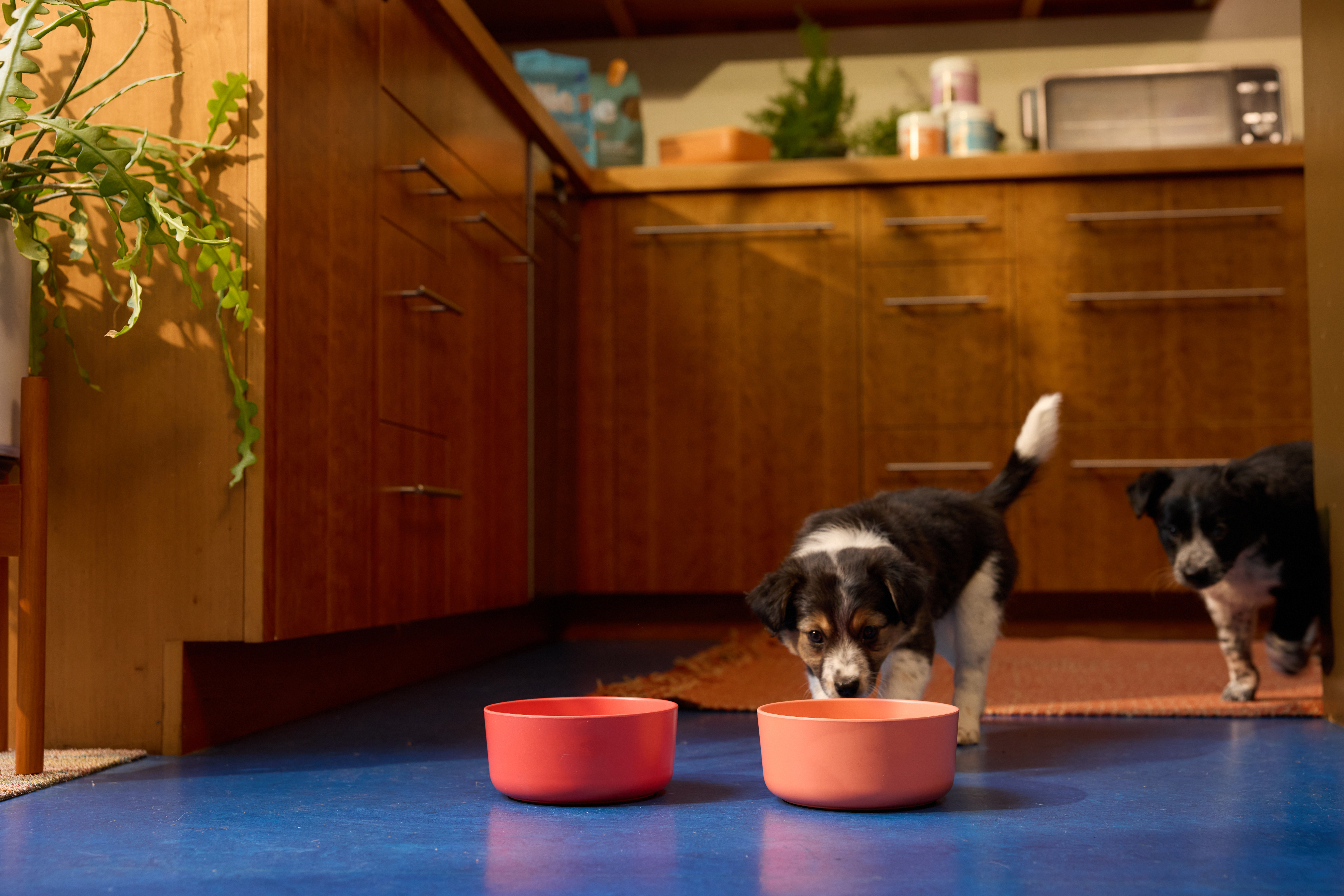Hey Ollie blog readers! We’re offering you an exclusive 60% OFF your starter box! Try now!
The right nutrition is essential in making sure your dog is living their happiest, healthiest life. A major factor in choosing the right diet is making sure your dog is able to actually use and absorb the nutrients in their food. With that in mind, as fresh dog food becomes more and more popular, you might be wondering if it’s really any easier for a dog’s system to handle than traditional kibble.
The short answer is that fresh, minimally processed food is generally more digestible for dogs than traditional dry kibble. This is supported by research showing that ingredient quality and processing methods significantly affect digestibility in canine diets[1]. Read on to get the full scoop on digestibility and how kibble stacks up to fresh food.
What Does “Digestibility” Really Mean?
When we talk about digestibility, we’re referring to how efficiently your dog’s body can break down food and absorb its nutrients. The more digestible a food is, the more vitamins, minerals, and energy your pup can extract from every bite. Less digestible food means more waste and fewer absorbed nutrients.
Studies indicate that fresh dog food is often more digestible and bioavailable than kibble. For example, research has shown that gently cooked or raw diets can have higher digestibility coefficients compared to extruded (kibble) diets[1]. The difference is rooted in the quality of ingredients and the way the food is prepared.
Why Fresh Food Is a Digestive Superstar
The digestive advantage of fresh food comes down to three key factors: ingredients, moisture, and processing.
| Feature | Fresh Food | Traditional Kibble |
| Ingredients | Human-grade meats, vegetables, and fruits | Feed-grade ingredients, meat meals, fillers |
| Processing | Gently cooked at low temperatures | High-heat extrusion, which can reduce some nutrients |
| Moisture Content | High (typically 70–80%) | Low (typically 10% or less) |
| Digestibility | Higher (studies report up to 90–94% for some fresh or raw diets)[1] | Lower (can be as low as 80% for some extruded diets)[1] |
Superior Ingredients and Gentle Cooking
Fresh food diets are built around real, whole-food ingredients—the kind you’d recognize in your own kitchen. Many commercial fresh diets use human-grade meats, fruits, and vegetables. This is a contrast to many kibbles, which often rely on processed meat meals, fillers like corn and soy, and artificial preservatives.
The cooking process is also important. Kibble is made using a high-heat, high-pressure process called extrusion, which can reduce the levels of some essential vitamins, amino acids, and natural enzymes that aid digestion[1]. Fresh food is typically gently cooked at lower temperatures to help preserve nutrient integrity and ensure safety.
The Power of Moisture
One of the most visible differences between fresh food and kibble is moisture. Fresh food naturally has a high water content, which is crucial for several reasons:
- Aids Digestion: Moisture helps break down food and transport nutrients through the digestive tract.
- Supports Hydration: It’s an excellent way to increase your dog’s overall water intake, which is vital for kidney function and overall health[2].
- Improves Palatability: Most dogs find the taste and texture of moist, fresh food more appealing.
Dry kibble requires the digestive system to work harder, pulling water from the body to begin the digestive process.
More Bioavailable Protein
The protein in fresh food comes from whole meat sources. This makes the protein more bioavailable, meaning it’s in a form that your dog’s body can easily recognize, absorb, and use to build strong muscles and support bodily functions[1].

The Health Benefits of Improved Digestion
When your dog can properly digest their food, the benefits ripple through their entire body. Pet parents who switch to fresh diets often report a wide range of positive changes.
- Better Stool Quality: This is often the first change pet parents notice. Better digestion means less waste. A study in the Journal of Animal Science found that dogs fed fresh or gently cooked diets had improved nutrient digestibility and smaller, firmer, and less frequent stools compared to dogs on extruded kibble[1].
- Healthier Skin and Coat: When your dog absorbs more fatty acids and other key nutrients, it shows in their coat, which can become shinier and softer. The absence of common allergens and fillers in fresh food can also reduce skin irritation[2].
- Increased Energy Levels: Efficient digestion means your dog gets more usable energy from their food, leading to more stable energy levels throughout the day.
- Stronger Immune System: A healthy gut is the foundation of a strong immune system. The variety of whole foods in a fresh diet can support a diverse gut microbiome, which is essential for fighting off illness. Furthermore, highly processed foods may contribute to low-grade inflammation, a factor in many chronic diseases[3].
- Improved Long-Term Health: Better nutrition can lead to better long-term health outcomes. Maintaining an ideal body weight, which is easier with portion-controlled fresh food, has been linked to increased lifespan in dogs[4].
Testimonial: “After switching my senior dog to Ollie, the change was incredible. His digestion improved within a week, his energy returned, and his coat has never looked better. I only wish we had made the switch sooner!” – Sarah P., Ollie Pet Parent

Make the Switch to a Healthier Diet
The evidence suggests that fresh food offers a digestive advantage over traditional kibble. By providing nutrients in a more natural and bioavailable form, it supports everything from your dog’s gut health to their energy levels and longevity.
If you’re ready to see the benefits of a fresh diet for your pup, Ollie makes it easy. We deliver perfectly portioned meals made with human-grade ingredients right to your door. We even offer mixed meal plans that combine our fresh recipes with our gently baked food, providing a nutrient-dense and convenient option.
Ready to make the switch? Start fresh with Ollie.
Frequently Asked Questions (FAQs)
Is fresh food really better than kibble?
While high-quality kibble can provide a balanced diet, fresh food is generally superior in terms of ingredient quality, processing, and digestibility. The gentle cooking process preserves more nutrients, and the high moisture content aids digestion and hydration, leading to numerous health benefits[1].
Will switching to fresh food help my dog’s sensitive stomach?
Many pet parents find that switching to a fresh food diet helps dogs with sensitive stomachs. Gently cooked fresh food is easier to digest than kibble and is free from the common fillers and artificial additives that can cause irritation. The limited, high-quality ingredients can also help pinpoint and avoid specific food sensitivities[2].
How do I transition my dog to a fresh food diet?
A gradual transition is key to avoiding digestive upset. Start by mixing a small amount of the new fresh food with your dog’s current food (about 25% new to 75% old). Over 7–10 days, gradually increase the amount of fresh food while decreasing the amount of the old food until you have fully transitioned[2].
Is fresh food more expensive than kibble?
Fresh food typically has a higher upfront cost than budget kibble due to its high-quality, human-grade ingredients and preparation methods. However, many pet parents view it as an investment in their dog’s long-term health, potentially leading to lower vet bills over time.
Citations
[1] https://www.ncbi.nlm.nih.gov/pmc/articles/PMC3704539/
[2] https://www.merckvetmanual.com/management-and-nutrition/nutrition-small-animals/nutrition-in-dogs
Tagged As:

The nutrition your dog needs,
the food they want.

Enjoying our articles? Subscribe our Newsletters and get new articles directly to your inbox
You might also like
4 August 2025
5 MINS READ
Key Ingredients in Fresh Dog Food Explained
The right food starts with the right ingredients. Unlike highly processed kibble, which can contain fillers and low-quality by-products, fresh food focuses on transparency and quality. At Ollie, w…
by Ollie Pets
4 August 2025
6 MINS READ
Fresh Dog Food Benefits for Growing Puppies
Proper nutrition as a puppy is the foundation for a long, healthy, and happy life. Fresh, human-grade meals can support your puppy’s rapid growth, brain development, and long-term health in ways…
by Ollie Pets
4 August 2025
6 MINS READ
Choosing Specialized Dog Food: Solutions for Allergies and Sensitivities
There’s nothing more difficult than seeing your dog uncomfortable. Constant scratching, upset stomachs, or chronic ear infections can be signs that something in their diet isn’t agreeing with …
by Ollie Pets







